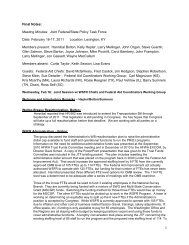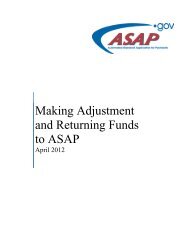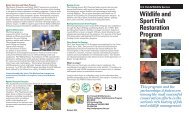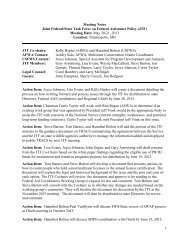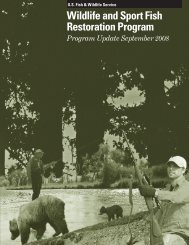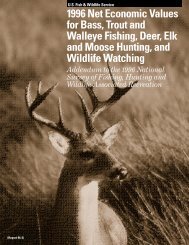Financial Returns To Industry From The Federal Aid - Wildlife and ...
Financial Returns To Industry From The Federal Aid - Wildlife and ...
Financial Returns To Industry From The Federal Aid - Wildlife and ...
Create successful ePaper yourself
Turn your PDF publications into a flip-book with our unique Google optimized e-Paper software.
National Survey data are reported at both the national <strong>and</strong> state level as well as three<br />
sub-categories based upon game pursued (big game, small game, <strong>and</strong> migratory bird).<br />
Whenever possible, estimates are most closely related to the data for a particular region<br />
or state <strong>and</strong> type of game animal pursued. However, the state-level data for a particular<br />
quarry (big game, migratory bird) lists only “equipment” which includes items outside of<br />
the tax related list. On the other h<strong>and</strong>, the national level report itemizes the equipment<br />
categories according to quarry <strong>and</strong> breaks out a specific “hunting equipment” category.<br />
<strong>The</strong>refore, the national level data allows the determination of exactly which items are<br />
tax-related <strong>and</strong> the amount spent by hunters across the nation. <strong>To</strong> accommodate these<br />
differences <strong>and</strong> add specificity to the state level analysis for individual case studies, the<br />
proportion of total purchases attributable only to tax related items at the national level<br />
was applied to total purchases at the state level to estimate purchases for tax related<br />
items at the state level. For example, to determine the dollars spent by big game<br />
hunters in Montana on taxable items, if big game hunting represents 16.7 percent of<br />
national purchases made by hunters for taxable items, then this same percentage, 16.7<br />
percent, is applied to the total purchases by hunters in Montana. 4<br />
<strong>Wildlife</strong> Restoration funds work to improve game-species habitat <strong>and</strong> populations<br />
directly. Many indirect effects also accrue as a result of those efforts, such as l<strong>and</strong><br />
preservation <strong>and</strong> species biodiversity. <strong>The</strong>se benefits go well beyond retail sales<br />
generated on tax-related items, but are outside of the realm of this investigation.<br />
<strong>The</strong> investment portion of the estimated return, again, is defined as either the actual<br />
<strong>Wildlife</strong> Restoration funds (for Excise Tax-Related ROI ) or total funds invested by all<br />
project partners (<strong>To</strong>tal Project ROI) to cover project costs. Overhead costs are not<br />
included at the case study level. Recording <strong>and</strong> accounting practices in place do not<br />
enable us to accurately capture project-related overhead costs at the case study level.<br />
At the national or macro-level, overhead costs are implicitly included in the Excise Tax-<br />
Related ROI estimation. With the exception of the macro-level analysis, all project<br />
investments, including <strong>Wildlife</strong> Restoration tax-related investment funds, are reported<br />
directly from the states in which the project exists.<br />
All costs <strong>and</strong> purchases are inflated to current-day (2009) purchasing power using an<br />
appropriate CPI provided by the Bureau of Labor Statistics.<br />
It is important to note two caveats with respect to interpretation of the return-oninvestment<br />
measure. First, the Excise-Tax-Related ROI excludes leveraged dollars<br />
from the definition of investments <strong>and</strong> therefore from the calculation. <strong>The</strong> result is that,<br />
in most but not all instances, some may consider the estimated return upwardly biased<br />
from the industry perspective. However, this is a valid approach since, without the<br />
investment of excise-tax dollars as a base, most projects would not be able to leverage<br />
4 This approach was ground-truthed using detailed National Survey estimates available for each state for 2006 only.<br />
<strong>The</strong> proportionally adjusted tax-related item purchases for 2006 did indeed align with the tax-related equipment item<br />
purchases calculated from the itemized state-level budgets. As a result, it is reasonable to utilize the proportional<br />
adjustment approach using state-level data in the case study analysis.”<br />
7




